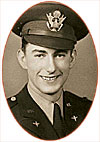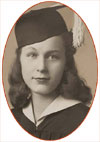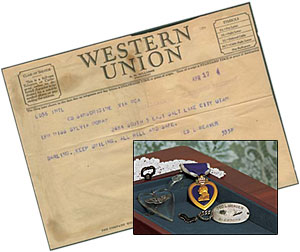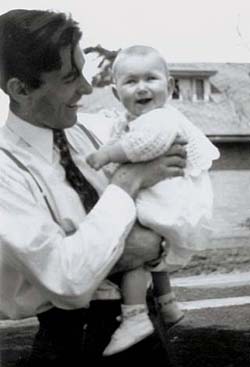 |
 |
| current issue |  |
past issues |  |
send a letter/news |  |
address update |  |
advertise |  |
about us |  |
alumni home |
Features
Connected by CourageFor two families, an extraordinary example of World War II heroism live on
by Jody Record '95

History is always different in person.
The written account of 1st Lt. Ted Weaver's plane being shot down over Nazi-occupied Holland in 1944 reads like a novel: hiding in a wheat field, with a German soldier searching for him just a few feet away. A dog that didn't bark. Families of the Dutch underground taking him in, moving him from house to house, until the town of Nijverdal was liberated nine months later.
In March, when UNH President Ann Weaver Hart--Weaver's daughter--went to Logan Airport to pick up a Dutch 15-year-old boy who was coming to America, Weaver's story came full circle.
Micha van Veldhuizen isn't just any Dutch student. His great-grandparents hid Hart's father from November 1944 until April 8, 1945, when Canadian troops entered Nijverdal.

|
Micha never knew of his connection to Hart until he decided to fulfill his English language requirement in the United States. Students in the Netherlands who attend a bilingual high school and want to earn an English diploma have to spend two to three weeks in an English-speaking country. When he was considering where to go, he asked his mother if she knew anyone in America. She mentioned Hart.
"I had never heard the story," he says. "We did a Google search and found her. Then later I asked my mother, how do you know Ann Hart?"

|
His grandmother, Annie van Harten, was a young woman in 1944. She spoke little of the war until her grandson heard about Hart and started asking questions. He just recently learned his grandfather, Kim van Veldhuizen, was an important leader in the Dutch resistance. Annie, a resistance messenger, was imprisoned for a time by the Germans, who were trying to entrap her husband.
Talking in the car
Ann Weaver Hart's experience was similar to Micha van Veldhuizen's.
"The only stories I heard in the late 60s were about how hard it was and how everyone who had hidden him made sacrifices," Hart says. "I think it was a little too painful, a little too difficult. Mom tells a story about the first night Dad was back home. They were sitting in the living room and the doorbell rang and Dad jumped up and hid behind the couch. Then he realized he didn't have to hide anymore."
 Listed as missing in action for nine months, Ted Weaver sent a telegram on April 17, 1945, to his sweetheart, Sylvia Moray, above. On their wedding day, May 31, 1945, she wore a heart that he had carved for her out of a crashed plane's windshield. Courtesy of Sylvia Moray Weaver |
Hart's mother, Sylvia Weaver, began encouraging her husband to record the events of those nine months. One day while driving in the car, Hart's uncle pulled out a tape recorder and told Weaver to start talking.
"Most of the tapes were made in the car, telling stories to my uncle," Hart says.
B-24 under fire
Ted Lionel Weaver was 23 years old when he piloted the B-24 bomber Full House on its 23rd mission over Holland. It was July 7, 1944. There were nine men on board. Their mission was to strike aircraft factories in Bernberg, Germany.
 Ted Weaver and daughter Ann, 1949.
Courtesty of Sylvia Moray Weaver
Ted Weaver and daughter Ann, 1949.
Courtesty of Sylvia Moray Weaver
|
The flight path was to take them across the northern tip of France and then into Germany. They were flying at an altitude of 20,000 feet when the plane came under fire. The enemy aircraft came out of nowhere, ME-110 fighters at one o'clock high. The strike lasted minutes. There was a rush of air into the crippled plane: smoke filled the cockpit. The radios were destroyed, and hydraulic fluid leaked over the rudder. The left outboard engine was the first to go. The crew stayed calm, adjusting their parachutes, waiting for Weaver's orders to abandon the plane.
The first man out was one of two wounded in the attack. His crewmates placed the ripcord in his hand, pushed him out the opening and yelled, "Pull!" Weaver speculated later that he was unconscious. He was killed when he hit the ground.
The young pilot ordered the crew to bail out while he tried to guide the limping plane. Six of the crewmen were captured and became prisoners of war. Two, including the wounded crewman, were killed. For nine months, Weaver was listed as missing in action.
Page: 1 2 Next >Easy to print version
blog comments powered by Disqus

